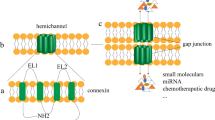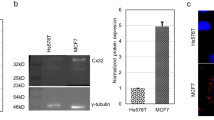Abstract
Background
Intercellular communication via gap junctions, composed of protein subunits called connexins (Cxs), plays a key role in controlling cell growth, differentiation and carcinogenesis. Impaired gap junctional intercellular communication has been reported in various cancers and diseases.
Aims
We investigated Cx32 expression patterns and semiquantitatively assessed Cx32 expression in cancers and preneoplastic lesions. To determine if cell proliferation is correlated with Cx32 expression, we evaluated Ki67 expression in a gastric cancer mouse model.
Methods
In human and mouse, normal stomach and gastric adenocarcinoma tissues were used for immunohistochemical analyses.
Results
Cx32 was detected at cell–cell (intercellular) contact points in normal cells and exhibited punctate intercellular and intracytoplasmic staining in cancer cells. The frequency of Cx32 loss of expression was significantly higher in human adenocarcinomas than in normal stomach. As tumor cells were less differentiated, Cx32 expression levels and intercellular and intracytoplasmic staining were also significantly lower. The Cx32 expression pattern in the mouse gastric cancer model was similar in several important respects to that of human. In mucous metaplasia of the mouse stomach, Cx32 was mainly expressed in the cytoplasm of epithelial cells. There was also an inverse correlation between Cx32 expression and cell proliferation in mouse tumors. However, there was no difference in the levels of Cx32 mRNA between normal and cancerous tissues.
Conclusions
These findings suggest that altered Cx32 expression, a loss of intercellular Cx32 and a gain of intracytoplasmic Cx32 in the form of punctate “dot”, plays an important role in the formation of gastric adenocarcinomas.




Similar content being viewed by others
References
Loewenstein WR, Rose B. The cell–cell channel in the control of growth. Semin Cell Biol. 1992;3(1):59–79.
Vinken M, et al. Biology and pathobiology of gap junctional channels in hepatocytes. Hepatology. 2008;47(3):1077–1088.
Alexander DB, Goldberg GS. Transfer of biologically important molecules between cells through gap junction channels. Curr Med Chem. 2003;10(19):2045–2058.
Willecke K, et al. Structural and functional diversity of connexin genes in the mouse and human genome. Biol Chem. 2002;383(5):725–737.
Monaghan P, et al. Gap junction distribution and connexin expression in human breast. Exp Cell Res. 1996;223(1):29–38.
Conklin C, et al. Tissue microarray analysis of connexin expression and its prognostic significance in human breast cancer. Cancer Lett. 2007;255(2):284–294.
Nakashima Y, et al. Expression of gap junction protein connexin32 in chronic hepatitis, liver cirrhosis, and hepatocellular carcinoma. J Gastroenterol. 2004;39(8):763–768.
Kanczuga-Koda L, et al. Alterations in connexin26 expression during colorectal carcinogenesis. Oncology. 2005;68(2–3):217–222.
Hong R, Lim SC. Pathological significance of connexin26 expression in colorectal adenocarcinoma. Oncol Rep. 2008;19(4):913–919.
Inose T, et al. Correlation between connexin26 expression and poor prognosis of esophageal squamous cell carcinoma. Ann Surg Oncol. 2009;16(6):1704–1710.
Jamieson S, et al. Expression of gap junction proteins connexin26 and connexin43 in normal human breast and in breast tumours. J Pathol. 1998;184(1):37–43.
Avanzo JL, et al. Altered expression of connexins in urethane-induced mouse lung adenomas. Life Sci. 2006;79(23):2202–2208.
Udaka N, Miyagi Y, Ito T. Connexin expression in mouse lung tumor. Cancer Lett. 2007;246(1–2):224–229.
Parkin DM, Laara E, Muir CS. Estimates of the worldwide frequency of sixteen major cancers in 1980. Int J Cancer. 1988;41(2):184–197.
Correa P, Houghton J. Carcinogenesis of Helicobacter pylori. Gastroenterology. 2007;133(2):659–672.
Correa P. Human gastric carcinogenesis: A multistep and multifactorial process—First American Cancer Society Award lecture on cancer epidemiology and prevention. Cancer Res. 1992;52(24):6735–6740.
Marshall B. Helicobacter pylori: Past, present and future. Keio J Med. 2003;52(2):80–85.
Fink C, et al. Specific localisation of gap junction protein connexin32 in the gastric mucosa of horses. Histochem Cell Biol. 2006;125(3):307–313.
Radebold K, et al. Gap junctional channels regulate acid secretion in the mammalian gastric gland. J Membr Biol. 2001;183(3):147–153.
Uchida Y, et al. Immunohistochemistry of gap junctions in normal and diseased gastric mucosa of humans. Gastroenterology. 1995;109(5):1492–1496.
American Joint Committee on Cancer, A.C.S. AJCC Cancer Staging Manual. New York: Springer; 2002.
Han SU, et al. Helicobacter pylori infection promotes gastric carcinogenesis in a mice model. J Gastroenterol Hepatol. 2002;17(3):253–261.
Kim B, et al. Cell cycle regulators, APC/beta-catenin, NF-kappaB and Epstein-Barr virus in gastric carcinomas. Pathology. 2010;42(1):58–65.
Madore J, et al. Characterization of the molecular differences between ovarian endometrioid carcinoma and ovarian serous carcinoma. J Pathol. 2010;220(3):392–400.
Grizzle WE, Myers RB, Manne U, Srivastava S, eds. Immunohistochemical evaluation of biomarkers in prostatic and colorectal neoplasia. Tumor marker protocols, Hanausek M, Walaszek Z, eds. Totowa, NJ: Human Press; 1998:143–160.
Mehta PP, et al. Suppression of human prostate cancer cell growth by forced expression of connexin genes. Dev Genet. 1999;24(1–2):91–110.
Shimoyama Y, Hirohashi S. Expression of E- and P-cadherin in gastric carcinomas. Cancer Res. 1991;51(8):2185–2192.
Jinn Y, Ichioka M, Marumo F. Expression of connexin32 and connexin43 gap junction proteins and E-cadherin in human lung cancer. Cancer Lett. 1998;127(1–2):161–169.
Shimoyama Y, Hirohashi S. Cadherin intercellular adhesion molecule in hepatocellular carcinomas: Loss of E-cadherin expression in an undifferentiated carcinoma. Cancer Lett. 1991;57(2):131–135.
Ogawa K, et al. Beta-catenin mutations are frequent in hepatocellular carcinomas but absent in adenomas induced by diethylnitrosamine in B6C3F1 mice. Cancer Res. 1999;59(8):1830–1833.
Takayama T, et al. Beta-catenin expression in human cancers. Am J Pathol. 1996;148(1):39–46.
Xu HT, et al. Connexin 43 recruits E-cadherin expression and inhibits the malignant behaviour of lung cancer cells. Folia Histochem Cytobiol. 2008;46(3):315–321.
Schwarz M, et al. Role of connexin32 and beta-catenin in tumor promotion in mouse liver. Toxicol Pathol. 2003;31(1):99–102.
Sanches DS, et al. Expression of connexins in normal and neoplastic canine bone tissue. Vet Pathol. 2009;46(5):846–859.
Edwards GO, et al. A quantitative inverse relationship between connexin32 expression and cell proliferation in a rat hepatoma cell line. Toxicology. 2008;253(1–3):46–52.
Bouzubar N, et al. Ki67 immunostaining in primary breast cancer: pathological and clinical associations. Br J Cancer. 1989;59(6):943–947.
Wang W, Luo H, Wang A. Expression of survivin and correlation with PCNA in osteosarcoma. J Surg Oncol. 2006;93(7):578–584.
Krutovskikh V, et al. Altered homologous and heterologous gap-junctional intercellular communication in primary human liver tumors associated with aberrant protein localization but not gene mutation of connexin32. Int J Cancer. 1994;56(1):87–94.
Vinken M, et al. Epigenetic regulation of gap junctional intercellular communication: More than a way to keep cells quiet? Biochim Biophys Acta. 2009;1795(1):53–61.
Anderson C, Catoe H, Werner R. MIR-206 regulates connexin43 expression during skeletal muscle development. Nucleic Acids Res. 2006;34(20):5863–5871.
Cronier L, et al. Gap junctions and cancer: New functions for an old story. Antioxid Redox Signal. 2009;11(2):323–338.
Acknowledgments
This work was supported by Brain Korea 21 Project. This study was partially supported by the Research Institute for Veterinary Science, Seoul National University.
Author information
Authors and Affiliations
Corresponding author
Rights and permissions
About this article
Cite this article
Jee, H., Nam, K.T., Kwon, HJ. et al. Altered Expression and Localization of Connexin32 in Human and Murine Gastric Carcinogenesis. Dig Dis Sci 56, 1323–1332 (2011). https://doi.org/10.1007/s10620-010-1467-z
Received:
Accepted:
Published:
Issue Date:
DOI: https://doi.org/10.1007/s10620-010-1467-z




